Hexadecagon
| Regular hexadecagon | |
|---|---|
|
A regular hexadecagon | |
| Type | Regular polygon |
| Edges and vertices | 16 |
| Schläfli symbol |
{16} t{8} |
| Coxeter diagram |
|
| Symmetry group | Dihedral (D16), order 2×16 |
| Internal angle (degrees) | 157.5° |
| Dual polygon | self |
| Properties | convex, cyclic, equilateral, isogonal, isotoxal |
In mathematics, a hexadecagon (sometimes called a hexakaidecagon) is a polygon with 16 sides and 16 vertices.[1]
A regular hexadecagon is a hexadecagon in which all angles are equal and all sides are congruent. Its Schläfli symbol is {16} and can be constructed as a quasiregular truncated octagon, t{8}, which alternates two types of edges.
Construction
As the ancient Greek mathematicians already knew,[2] a regular hexadecagon is constructible using compass and straightedge:
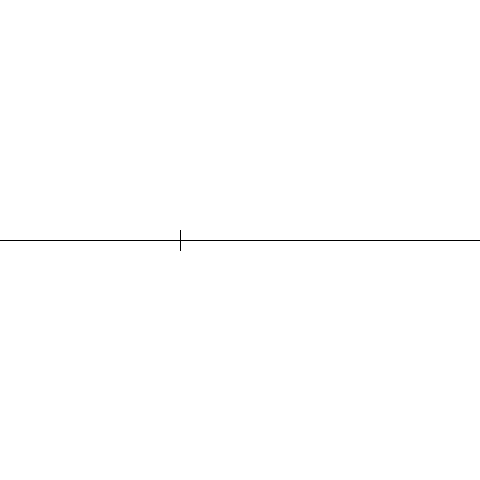
Construction of a regular hexadecagon
Measurements
Each angle of a regular hexadecagon is 157.5 degrees, and the total angle measure of any hexadecagon is 2520 degrees.
The area of a regular hexadecagon is: (with t = edge length)
Because the hexadecagon has a number of sides that is a power of two, its area can be computed in terms of the circumradius r by truncating Viète's formula:
Related figures
A hexadecagram is an 16-sided star polygon, represented by symbol {16/n}. There are three regular star polygons, {16/3}, {16/5}, {16/7}, using the same vertices, but connecting every third, fifth or seventh points. There are also three compounds: {16/2} is reduced to 2{8} as two octagons, {16/4} is reduced to 4{4} as four squares and {16/6} reduces to 2{8/3} as two octagrams, and finally {16/8} is reduced to 8{2} as eight digons.
| Form | Convex polygon | Compound | Star polygon | Compound |
|---|---|---|---|---|
| Image |  {16/1} or {16} |
.svg.png) {16/2} or 2{8} |
 {16/3} |
.svg.png) {16/4} or 4{4} |
| Interior angle | 157.5° | 135° | 112.5° | 90° |
| Form | Star polygon | Compound | Star polygon | Compound |
| Image |  {16/5} |
.svg.png) {16/6} or 2{8/3} |
 {16/7} |
.svg.png) {16/8} or 8{2} |
| Interior angle | 67.5° | 45° | 22.5° | 0° |
Deeper truncations of the regular octagon and octagram can produce isogonal (vertex-transitive) intermediate hexadecagram forms with equally spaced vertices and two edge lengths. [3]
A truncated octagon is a hexadecagon, t{8}={16}. A quasitruncated octagon, inverted as {8/7}, is a hexadecagram: t{8/7}={16/7}. A truncated octagram {8/3} is a hexadecagram: t{8/3}={16/3} and a quasitruncated octagram, inverted as {8/5}, is a hexadecagram: t{8/5}={16/5}.
| Quasiregular | Isogonal | Quasiregular | ||
|---|---|---|---|---|
 t{8}={16} |
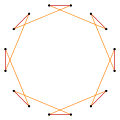 |
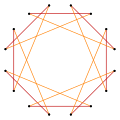 |
 |
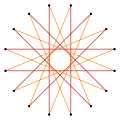 t{8/7}={16/7} |
 t{8/3}={16/3} |
 |
 |
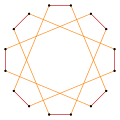 |
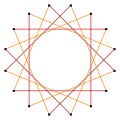 t{8/5}={16/5} |
Petrie polygons
The regular hexadecagon is the Petrie polygon for many higher-dimensional polytopes, shown in these skew orthogonal projections, including:
| A15 | B8 | D9 | 2B2 (4D) | |||
|---|---|---|---|---|---|---|
 15-simplex |
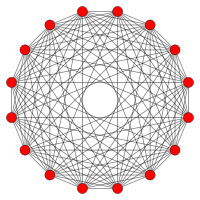 8-orthoplex |
 8-cube |
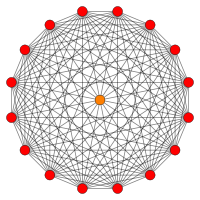 611 |
 161 |
 8-8 duopyramid |
 8-8 duoprism |
In art
_-_WGA18625.jpg)
In the early 16th century, Raphael was the first to construct a perspective image of a regular hexadecagon: the tower in his painting The Marriage of the Virgin has 16 sides, elaborating on an eight-sided tower in a previous painting by Pietro Perugino.[4]
Hexadecagrams, 16-pointed star polygons, are included in the Girih patterns in the Alhambra.[5]
Irregular hexadecagons
An octagonal star can be seen as a concave hexadecagon:
References
- ↑ Weisstein, Eric W. (2002). CRC Concise Encyclopedia of Mathematics, Second Edition. CRC Press. p. 1365. ISBN 9781420035223.
- ↑ Koshy, Thomas (2007), Elementary Number Theory with Applications (2nd ed.), Academic Press, p. 142, ISBN 9780080547091.
- ↑ The Lighter Side of Mathematics: Proceedings of the Eugène Strens Memorial Conference on Recreational Mathematics and its History, (1994), Metamorphoses of polygons, Branko Grünbaum
- ↑ Speiser, David (2011), "Architecture, mathematics and theology in Raphael’s paintings", Crossroads: History of Science, History of Art. Essays by David Speiser, vol. II, Springer, pp. 29–39, doi:10.1007/978-3-0348-0139-3_3
|first1=missing|last1=in Editors list (help) . Originally published in Nexus III: Architecture and Mathematics, Kim Williams, ed. (Ospedaletto, Pisa: Pacini Editore, 2000), pp. 147–156. - ↑ Hankin, E. Hanbury (May 1925), "Examples of methods of drawing geometrical arabesque patterns", The Mathematical Gazette 12 (176): 370–373, doi:10.2307/3604213.
External links
| ||||||||||||||||||||||||||





